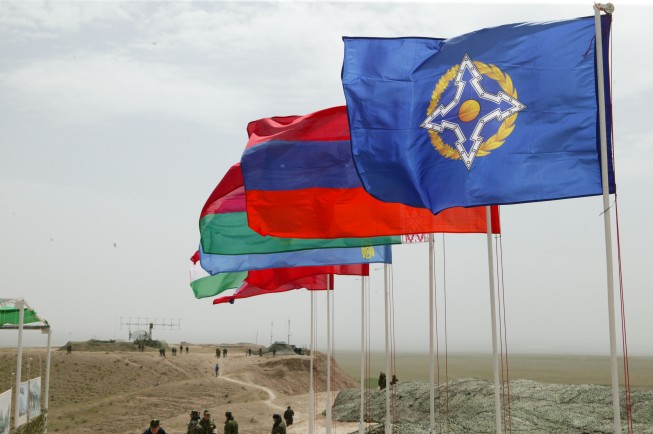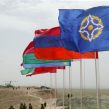
Russia Proposes to Codify Intervention Right Via CSTO
Publication: Eurasia Daily Monitor Volume: 8 Issue: 168
By:

CSTO’s Secretary-General, Nikolai Bordyuzha, has expatiated on proposals to use the Collective Security Treaty Organization as a tool of Russian intervention within member countries. His latest statements focus on managing hypothetical internal upheavals in member countries (Belarus, Armenia, Kazakhstan, Kyrgyzstan, Tajikistan, Uzbekistan) via the Russian-led CSTO.
These clarifications follow up to those by presidential adviser, Igor Yurgens, and by Bordyuzha himself, selectively disclosing parts of Moscow’s plan to reorganize the CSTO. Coordinated by Yurgens at the Institute for Contemporary Development (INSOR, President Dmitry Medvedev’s in-house think-tank), the reorganization plan is a Russian inter-agency product, not in any sense a collective CSTO product (see EDM, September 8, 9).
Russian political and military planners profess to anticipate “Arab-revolution”-type upheavals and regime-succession crises in the CSTO-claimed “area of responsibility” [a Russian-claimed sphere of influence]. Those eventualities, according to Bordyuzha, would provide cause to activate the CSTO. The organization would become involved if the legally elected head of the state concerned requests CSTO assistance. In that case, the CSTO could intervene to “protect the constitutional order.”
Moscow apparently envisions conflict scenarios involving a variety of actors, state and non-state. According to Bordyuzha, CSTO intervention could take the form of mediation services by its expert groups or governmental bodies, negotiations at the diplomatic level, deployment of CSTO-flagged troops, or would combine those forms. Mediation and diplomacy would be the first resort, with troop deployments as a last resort. CSTO’s troops are being termed, whether glibly or deliberately, “peacekeepers,” without clarifying whether the designation would apply to police or military, the management of civil conflicts or inter-state ones, or mandate-granting and command authority.
If deployed, CSTO “peacekeepers” would supposedly act impartially, not side with any local rival forces, avoid involvement in political struggles, and use arms in self-defense only. These troops could be introduced for separating parties to a conflict from each other, restoring civil order if local authorities are unable to cope on their own, and opening the way for political mediation via the CSTO. At present, Moscow wants member countries to grant the CSTO a “legal mandate” to perform mediation in conflict situations. It even wants this mandate to be granted in advance, as a blank check and a framework for decision-making down the road on a case by case basis.
Any CSTO intervention would be authorized, ostensibly, by CSTO’s Council of Heads of State. It would be asked to decide by majority-voting to deploy troops or other forms of security assistance in the CSTO-claimed “area of responsibility.” According to Bordyuzha’s summary of the reorganization plan, “approval by the UN Security Council would not be necessary” for such interventions (Interfax, September 11; Rossiyskaya Gazeta, September 12).
The Russian Armed Forces’ General Staff has participated alongside other agencies in the INSOR-coordinated drafting work. The Chief of Staff, Army-General Nikolai Makarov, proposes to accelerate preparations for creating “collective” forces on standby for possible interventions. Thus, the Russian military intends to shift the emphasis in CSTO exercises toward rapid deployment of troop contingents for crisis prevention and crisis response (CSTO exercises have emphasized anti-terrorism in recent years). According to Makarov and other Russian officials, the unforeseen turmoil in North Africa and Middle East served as an eye-opener. The combination of social discontent and leadership succession problems in the Arab world raised (so these Russian officials claim) the possibility of analogous events in Central Asia and elsewhere in CSTO’s “area of responsibility” (Interfax, September 12; Vedomosti, September 13).
Whether such threat perceptions are genuine (if overblown) or deliberately manipulative is, ultimately, a question of secondary relevance. The operative significance of these intentions is to rationalize an exclusive claim of Russian intervention, under CSTO’s cover, in formerly Soviet-ruled territories, across that “privileged zone of Russian interests” claimed by Russian officials from President Medvedev on down. In practice, only Russia can initiate and execute an intervention and make it look “collective” by squeezing minor contributions from reluctant allies.
CSTO member countries are reacting with caution to these plans. Some member countries are said to resist quietly, with the usual delaying tactics. Belarus has a track record of blocking Russian initiatives for tighter integration in the CSTO. President Alyaksandr Lukashenka continues to oppose any CSTO involvement in internal or civil crisis situations. However, unfounded “color revolution” fears may have prompted a partial reconsideration. At present, Lukashenka takes the position that a CSTO response could be justified in the event of a coup organized from the outside, but “not when workers and peasants come out into a square. The issue is [about] intervention from the outside” (Belarus TV, September 9; Interfax, September 10).
Tajikistan is now under pressure to accept a 49-year prolongation of the basing rights of Russian troops in the country, and a return of Russian border troops to the Tajik-Afghan border. A reluctant Tajikistan finds other partnerships more attractive. For its part, Uzbekistan openly rejects Moscow’s proposal to replace the unanimity rule with majority voting on CSTO decisions. Under the organization’s existing charter, unanimous consent is required for collective decisions to have validity. This safeguard, however, does not operate in international law (it is a CSTO procedural matter), and looks like a thin reed against potential discretionary actions by Russia in the future.




